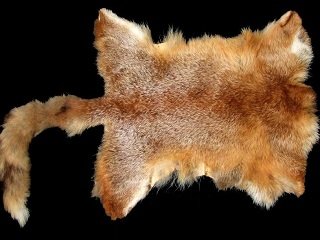 If you have ever sent in an animal skin or hide of any kind and got back a perfect tan, you were lucky. There is no possible way to guarantee a good tan. Every single tanning job in the history of the world had chance involved. There are two things that make a great tan for taxidermy: the hair is still on in all the places it should be and the hide is shaved well and evenly, is supple and has stretch.
If you have ever sent in an animal skin or hide of any kind and got back a perfect tan, you were lucky. There is no possible way to guarantee a good tan. Every single tanning job in the history of the world had chance involved. There are two things that make a great tan for taxidermy: the hair is still on in all the places it should be and the hide is shaved well and evenly, is supple and has stretch.
Bacteria and hair loss. Some taxidermists, that do their own tanning, will tell you tales of "never" having a bad tan, but that nugget of info is worthless. It is just a matter of time. Bacteria are the cause of all hair loss and there is no possible way to safeguard against bacteria no matter how hard you try.
I have had hundreds of skins professionally tanned at over 2 dozen tanneries in the last 20 years as a taxidermist. Bad tanning is like cancer; there is no possible way to tell you how it happened or what caused the hair to ‘slip’ or be lost. You can only speculate. You may think you prepared your skins properly, but you don't know what freak bacteria was on your skinning knife that day or what might have touched your skin to spread bacteria.
You might not have even been aware that some form of heat washed over your skins temporarily on accident which could have sped up bacteria growth. You just can't ever know what caused a ‘slip.’ There might have been something that brushed up against your hands or knife blade or some weird bacteria that your animal was hosting.
It could have been from the animal riding in the bed of a truck and the wind blew the exhaust upward and heated the bed for a moment. The wind could have blown some bacteria into the area, or on the animal. There are endless freaky things that could have happened.
Shaving. Here is what I have learned over the years. Even if a tannery has a great reputation, it is only as good as the person working the round knife. That is a round bladed knife that is turned by an electric motor that shaves skins into thinner form so that chemicals can saturate them and oil can soften them up. Tanneries have high turn-over because tanning is hard work and workers move on.
The nasty truth of the tanning industry is that right when a tannery employee gets good with a fleshing machine; they have had enough of tanning and move on. Most reputable tanneries, like the one you might have used, have set formulas for their acids, neutralizers and tanning oils. So, the X-factor is the people doing the tanning. Before you send any skins anywhere, insist on talking to the owner of the tannery and ask them if they have a new guy on the knife or a long-time, efficient employee. Express your worries. It is only good business and common sense.








